|
egy.com suggests following articles
|
|
Several of my articles on Garden City were plagiarized word for word by novelist MEKKAWI SAID (winner of the Egyptian State price for literature!!!!) and re-published under his own name in a three-part series in El-Masry El-Youm daily in September 2015. Cheers to our "talented" literature prize awardee. Your pain his gain !!!
|
EGY.COM - MAADI
MADAME SIMONA
a pre-WW2 Maadi resident
by Samir W Raafat
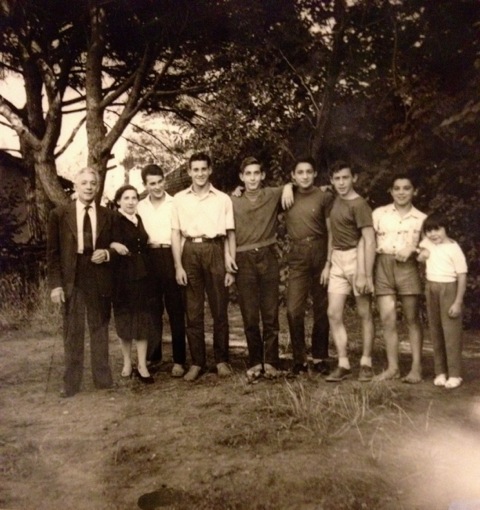
The Simona family in "Les Platanes" Ollioules, South of France:
Henri, Gaby, Pierre, Jean-Louis, Francois, Bernard, Jean-Claude, Alain, Anne
above photo courtesy Pierre Simona
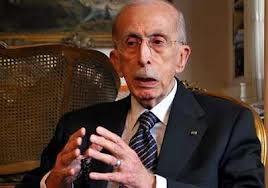
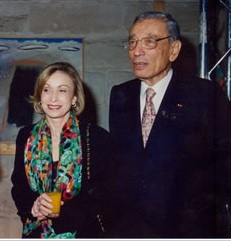

les eleves de Madame Simona: L-R
International Tribunal judge Amin Al Mahdi
Shahnaz Al Mahdi (with Boutros Ghali, Francophonie sec-gen during Mitterand era)
Sherif W Raafat former Egyptian Bourse chairman
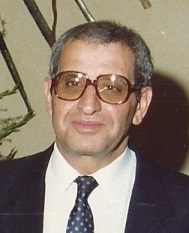
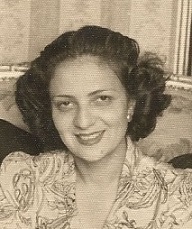
prize student Ambassador Aziz Seifelnasr and his mother
"Madame Soad" (Foda) Seifelnasr helped Madame Simona obtain a pension from Egyptian government
two photos courtesy Dina Alhassani
To her students she was simply "Madame Simona". None knew her past and very little of her present. She never mentioned her age or that she was born in Alexandria on 15 December 1887. Madame Simona was not into small talk. But as she approached her twilight years, she sometimes digressed about her only son Henri "Riri" and her favorite Cairo-born grandson Pierre who, at the time, was a struggling artist in Paris.
Occasionally Madame Simona mentioned her other six grandchildren reducing their pastoral existence in "Les Platanes to that of one big struggle. "Les Platanes was the name of their bastide in Quartier Quiez, Ollioules in France's VAR region. From Madame Simona's rambles one got the impression France was going through hard times due to Algeria's bloody war of independence. "No wonder Madame Simona preferred Egypt to her native France," we often told ourselves.
From WW2 up until the early '60s Louise Simona lived mostly by herself. She occupied a quaint rental on Road 13 situated above Maadi's Lilliputian fire brigade right next to the tiny Qism police station. The top floor of this rudimentary two-story stone building boasted two apartments. The larger one was occupied by Madame Simona. She rented it from the Maadi Delta Company for LE 2 (two) pounds a month. It came with a large terrace overlooking Khashaab Canal and its giant Eucalyptus trees. The smaller apartment was allocated to Maadi's Police commissioner. Hence Madame Simona's students invariably came face to face with Commissioner Sayed Makram and later his replacement "Monsieur" Labib.
The enemy next door!
Both policemen respected and watched over Madame Simona. In fact, when French nationals were evicted from Egypt following the 1956 Suez War, Madame Simona was the exception. She remained in Egypt under pseudo-house arrest or "residence forc e" as she would say. Commissioner Labib allowed Madame Simona to do her Maadi rounds unimpeded. In return she taught French to the congenial Madame Labib. It was one happy family at No. 66 Road 13. (see below Madame Simona's petition dated 24 November 1956)
Unable to travel to France in 1957 and 1958 because of exit-visa restrictions, Madame Simona summered in Alexandria with the family of one of her students. Each day the family, with Madame Simona in tow, drove to their beach cabin in plage Semiramis located inside Montazah Palace. Once there, with the help of a walking stick, she shuffled over to the nearby cabin of the Al-Mahdy family. Later in the day she was picked up by her hosts for the return journey home.
Summer home during these two years were tiny quarters in her host's apartment on the fourth floor of the posh Coutarrelli building overlooking the smart Saba Pasha district. Compared to Madame Simona's Spartan Maadi apartment, her tiny room and bathroom in Alexandria were un grand luxe.
Having been one of Madame Simona's Maadi students I regularly visited her apartment. It smelt of mothballs and cat urine. The emaciated feline was called Tip-tap. It sat on Madame Simona's desk purring away while the no-nonsense teacher had me recite Moliere and Racine. Everything in the room reeked of old. The only thing linking Madame Simona's past to her future was a framed sepia photo of her son in army uniform. "Riri" had enlisted in de Gaulle's Free French during WW2.
During the pre-WW2 years Henri Simona was an architect with the Egyptian Survey Authority. Born and raised in Cairo Henri discovered an Egypt where French influence was at its peak: French schools, French opera, French banks, French boutiques, French judges, French Egyptologists, French hospitals, French medics and French architects. Understandably the lingua franca, especially among highborn Egyptian society was French!
The privileged Simonas felt so at home in Egypt they never considered re-settling in France where they would have joined the ranks of Monsieur et Madame Tout le Monde. In Cairo they had considerable khawaga status unmatched in their country of origin. And since the people they frequented spoke French they never bothered to learn Arabic.
How ironic that after a lifetime in Egypt my teacher only spoke French whereas all her students were trilingual!
But if the Simonas lived high on the hog in Egypt, life as a couple was devoid of amour if one believed Madame Simona's rare snippets of her conjugal life. The family's Zamalek apartment on King Fouad (renamed 26th of July) Avenue was not always a happy one. Papa Simona, which is how Madame Simona referred to her husband, seemed totally indifferent to his mate's carnal needs. Edmond Simona found tendresse and maitresse elsewhere. And as though to express his marital feelings he hung his wife's only portrait on the back of the water closet door. This way, whenever one sat on the john, Madame Simona watched. Papa Simona equated his wife with a purge!
In her widowhood Madame Simona claimed and received a monthly pension from the Egyptian government. This timely stipend was the welcome legacy left by her late husband who had spent a lifetime working at the Mixed Courts. An administrative official he was known to everyone of importance within the legal profession. Thus, Papa Simona redeemed himself in the eyes of his abandoned wife.
Not the stay-at-home type Madame Simona taught piano to Egypt's society damsels. Later as a widow she taught French for she had once been a teacher at the Lyc e Francais. It was at this school that her daughter in law had become a tenured teacher. The two French women did not get along.
Madame Simona did not fancy her in-laws.
Henri had married Gabrielle "Gaby" the only daughter of Monsieur et Madame Ferdinand Auby who lived at No. 88 Kasr el-Eini Street. Monsieur Auby worked for the Compagnie de Gaz et Electricite (LEBON).
Although still in my preteens I quickly learned that if I wanted to distract my diligent French professor from her teaching chores, I need only ask "Et quelle nouvelle de Gaby?" A seemingly innocent question that prompted immediate humph, haws and endless grumbles. Utterings typical of an exasperated belle-mere. Most definitely Madame Simona n'aimait pas sa bru!
During her widowhood Madame Simona was a private tutor to a selection of lofty Egyptian families already known to her from her piano-teaching days. Topping her list was the Abdelhamid Cherif and Abbas Al-Mahdi Pasha families. Next on the list were their Maadi cousins the Ali Gherianis: Djedah and her brother Medhat.
Four generations of devoted service.
In her tender years' Madame Simona had been Mlle de compagnie to Fatma Kamal Hanem the wife of wealthy landowner Abdelhamid Cherif "bey". Thereafter she taught French and piano to Fatma Hanem's daughters including Zeinab "Zizi" Cherif Hanem who later became known as Madame Abbas El-Mahdy Pasha. Eventually Madame Simona taught French to Zizi's children and grandchildren. This she would do over the weekend at the palatial Cherif mansion on Manial al-Roda Island. Therein the French teacher had her own living quarters. Each week a car would fetch her from her Maadi dwelling bringing her back two days later, always with a basket full of food. The frugal Madame Simona was highly estimated by the Al-Mahdi family.
Prize students.
Of her Manial Island students one, Amin al-Mahdi, would much later head the prestigious Conseil d'Etat or Chief Justice of the Egyptian Council of State. Later, he became minister of social justice. Meanwhile, his youngest sister, Shahnaz a.k.a "Sheri" became Egypt's first lady in Paris as wife of Ali Maher the Egyptian Ambassador to France. Her French hosts whether at Hotel Matignon, the Elysees or Quai d'Orsay, were forever amazed at her proficiency of la langue de Moliere. The answer was always the same: Madame Simona!
Another prize student was Aa-ziz who became Egypt's ambassador to Lisbon and Mexico City. His son (Hatem Aziz Seifelnasr) was in turn ambassador to France. Madame Simona would gush with pride whenever she mentioned Aziz or his mother Madame Soad Seifelnasr Bey.
Madame Simona would never live to see her prize students at their peak. She left Egypt an octogenarian in the mid-1960s. The upside to this final voyage was that she would reunite with her beloved Riri. But an unpleasant surprise awaited her in the south of France.
Old age had taken Madame Simona to "Les Platanes" but it would be an uncomfortable stay since she was obliged to share the facilities with her aging rival--Henri's mother in law. Madame Auby Mere had moved in a few years earlier and established precedence.
We knew we would no longer see Madame Simona when Henri suddenly arrived in Maadi for a brief stay. He had come to collect his mother's personal belongings.
Years later came a sad message from France: Mother and son were companions in the same Maison de Vieillesse or retirement home where they were expected to spend their remaining years.
Madame Simona expired shortly thereafter. Henri survived his mother by several years.
In Egypt her abandoned apartment was eventually taken over by the expanding Maadi precinct. But by then the Egypt of Madame Simona had already disappeared.

the famous Platane tree which lent its name to Henri's home in Ollioules
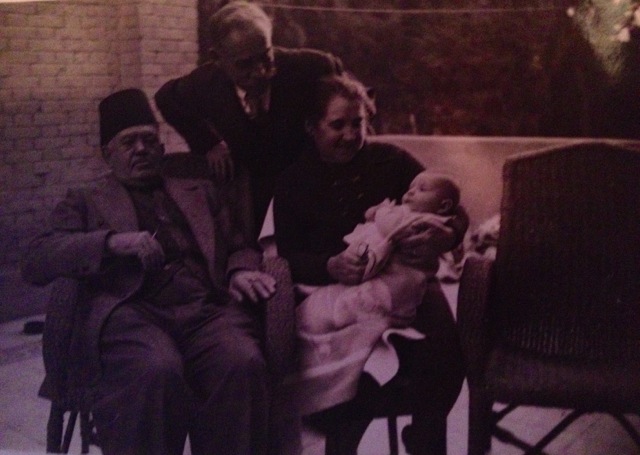
Maadi 1938: Monsieur and Madame Auby admiring their first-born grandson Pierre with Edmond "Papa" Simona standing
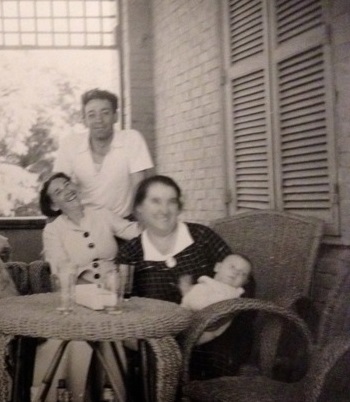
Maadi 1938: Henri ("Riri") standing behind a happy Gaby with baby Pierre in the arms of his maternal grandmother Madame Auby
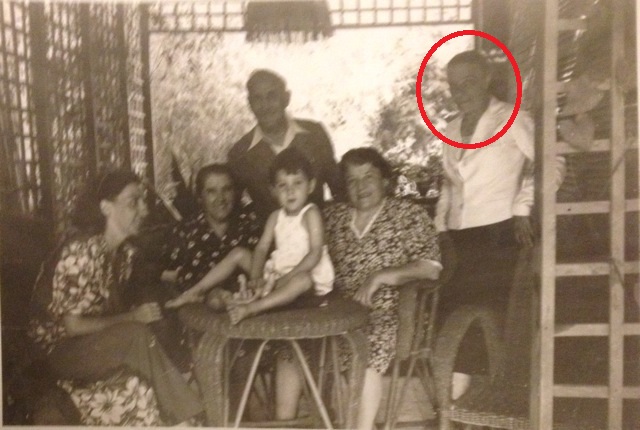
Maadi three years later with Madame Simona standing (red circle) and young Pierre on table
photos courtesy Pierre Simona

pre-WW1 Maadi building No 66 Road 13 owned by EDLICO (Egyptian Delta Land Company)
Top floor consisted of two apartments separated by a large terrace. Incorporated into the Maadi Police Station in 1978
Ground floor originally divided into EDLICO warehouses and the Maadi Fire Brigade. Now divided between a Cairo Electric Authority warehouse and the Maadi Police Station
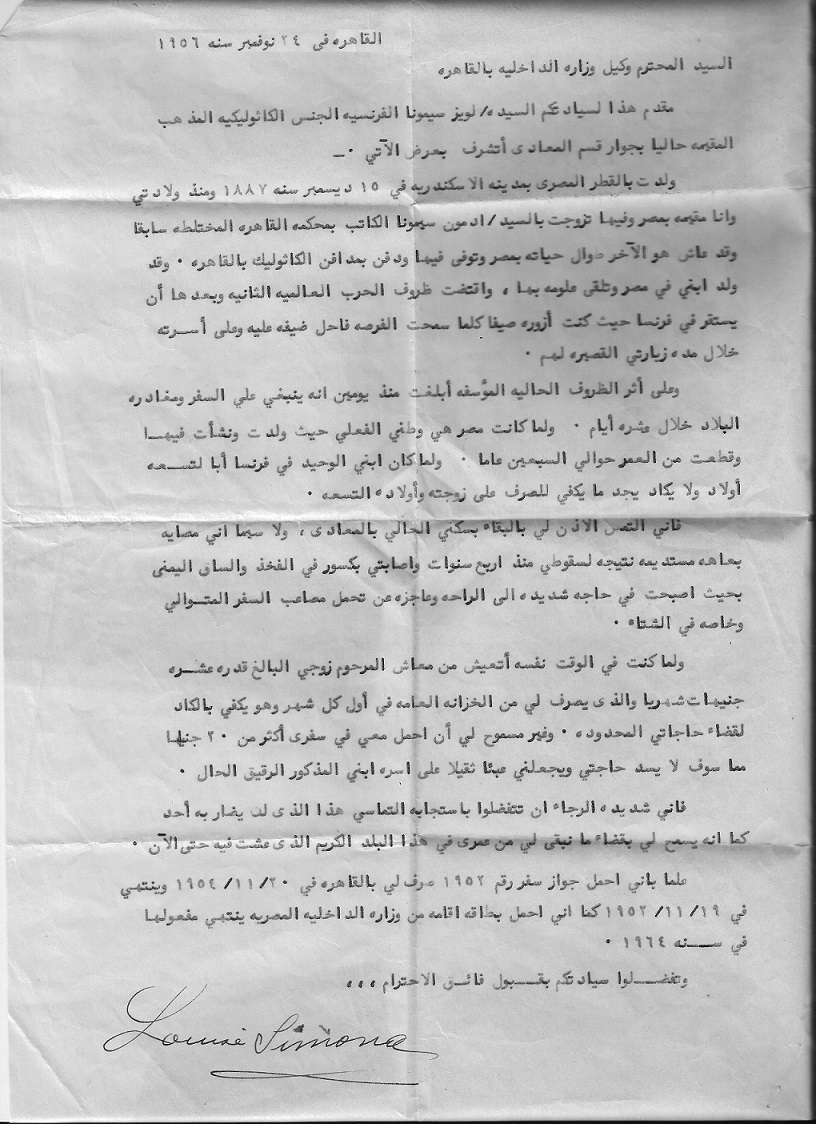
Madame Simona's 24 November 1956 petition to the Ministry of Interior requesting permission to remain in Egypt for compassionate reasons
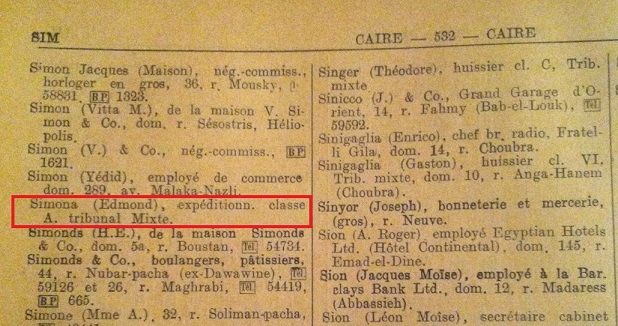
entries in a 1934 and 1937 Egyptian Commercial Directory
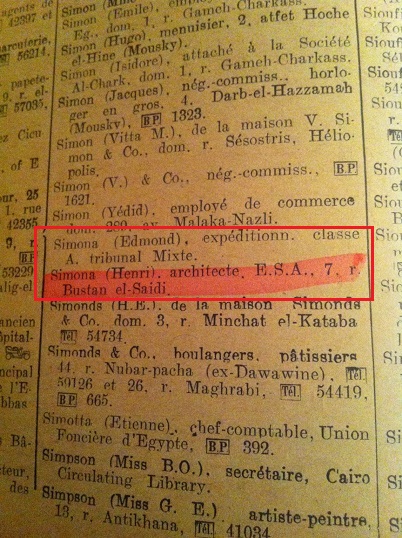
father and son listed in directory
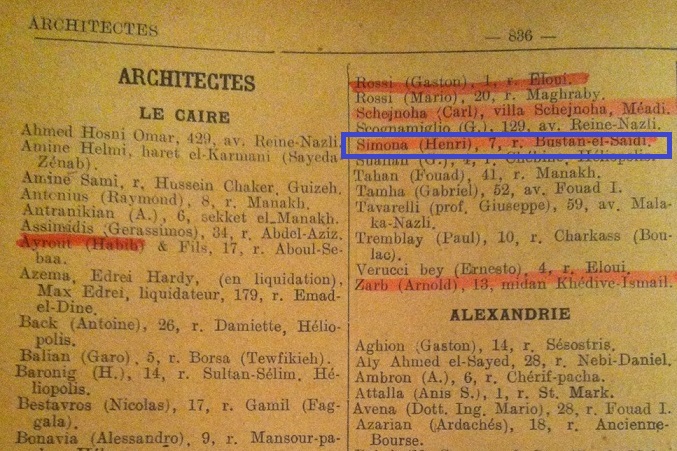

cover of The 1934 Egyptian Commercial Directory


Pierre Simona's Paris vernissage in 2011

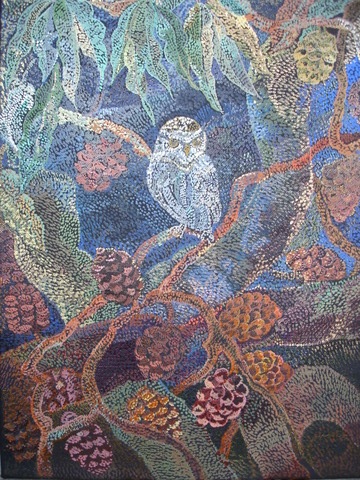
Email your thoughts to egy.com
© Copyright Samir Raafat
Any commercial use of the data and/or content is prohibited
reproduction of photos from this website strictly forbidden
touts droits reserves



















